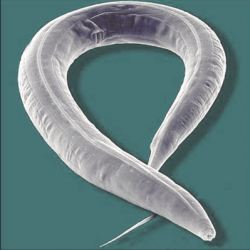
Scientific experiments require subjects - which are infrequently humans for many (obvious) reasons.
Although closely related, non-human primates are expensive and have serious ethical questions. Other, smaller mammals are used more regularly, but are limited as they are expensive to house and its hard to use a large number of them at the same time. In experimentation, more "n" or data points is almost always better.
Because of this, researchers look to a host of alternatives. One of the most popular is the roundworm, Caenorhabditis elegans (C. elegans).
It may seem strange that many important, scientific questions are being answered using a worm that is the size of a comma on this page, but it is indeed, an incredibly powerful experimental system.
C. elegans can be handled, essentially, as easily as you work with bacteria. They are small, (about 1mm long as adults) which makes doing an experiment with thousands of animals feasible, relatively easy and inexpensive.
They live on petri plates, eat bacteria, can be frozen and thawed, and are happy at room temperature - no special housing needed.
They are self-fertilizing hermaphrodites, so, a scientists doesn't need to worry about mating. Just leave one worm on a plate for a week and there will be 300 more worms before you know it. They also grow up fast, aging from embryo to adulthood in about three days. This particular feature makes them the mainstay of aging research as you can do multiple experiments every year looking at the full life span of a set of worms. In mice, it would take years to complete one such experiment.
C. elegans are also transparent, so the internal anatomy can be seen without using any special techniques.
In 1998, C. elegans was the first animal genome sequenced (100.3 Mb in size - about 1/30 the size of the human genome - with 21,733 predicted genes.) Not only that, but, there is an incredibly useful online resource, wormbase, that is a wealth of information that serves to support genetic understanding of C. elegans.
The have different body systems, including a nervous system with 302 neurons, one of the more attractive areas to research in the worm.

Figure courtesy of http://www.sfu.ca
C. elegans was developed as a model system in the lab by Sydney Brenner roughly 55 years ago, in the early 1960s, work that earned the Nobel Prize in 2002, along with the other pioneers in this field, John Sulston (currently at the University of Manchester, England) and Bob Horvitz (who has spent his career at MIT.)
Other breakthroughs that have come about because of the worm are pioneering work on how cells have a programmed system to destroy themselves - known as apoptosis. Also, small RNAs and their role in gene expression was discovered in worms in the 1990s, winning another Nobel Prize (2006.) Worms were also at the heart of the 2008 Nobel Prize that was awarded for the first use of green fluorescent protein (GFP) in animals.
And, those are just the most notable achievements that have won the most prestigious award. There are countless past discoveries made through work with worms and, as worm research grows, there are certain to be many more in the future.

